As animation began to find its niche in television mass production during the mid-to-lare 50’s and early ‘60’s, the circus still remained a prominent fall-back genre for screenwriters – sort of like a safety net for a trapeze artist – which would be turned to again and again on both big and small screens.

For the theaters, there were still films such as “Trapeze” (1956) with Burt Lancaster, Tony Curtis, and the American premiere of Gina Lollobrigida. Dean Martin ad Jerry Lewis would end their association with “3 Ring Circus” (1954). Danny Kaye would clown around in “Merry Andrew” (1958). Later, Disney would supply Kevin Corcoran with the memorable role of “Toby Tyler, or Ten Weeks With a Circus” (1960). Famous hobo clown Emmett Kelly would try his hand at the big screen for the kiddie matinee circuit in “The Clown and the Kids” (1967). And there were even such off-beat circus tales as Tony Randall’s “The 7 Faces of Dr. Lao”, directed by George Pal (1964). On the small screen, Screen Gems would provide “Circus Boy” (1956-58), with a young Mickey Dolenz and co-star Noah Beery Jr. Claude Kirshner would host “Super Circus” for many years for Kelloggs – then do commercials for circus-themed shooting gallery toys for Marx into the 1960’s. Don Ameche would host the prime-time “International Showtime” (1961-65), bringing into your living room a new circus virtually every other week. Yes, entertainment in general wanted to make sure the American public still had sawdust in their blood, and early animation for TV of course followed such trends with recurring appearances of circus stories, and in some instances, whole series or sub-series devoted to circus-related characters.
A little shorter than usual today on embeds, as I’m borrowing video downloads from a previous article published on this website. We’ll cover the television output of UPA and Larry Harmon Studios.
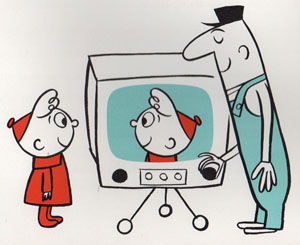 The Boing Boing Show was a CBS prime-time affair starting in 1956. Gerald, the academy-award winning Dr. Seuss character who appeared in five theatrical shorts for UPA, actually does next to nothing except appear in the credits and brief interstitial bumpers to introduce various categories of miscellaneous shorts with his sound effects. After many years of unavailability, some of his incidental footage has finally surfaced on the internet, but there appear to be some soundtrack rights issues, as the music and narration (except for Gerald’s sound effects) seems to be completely redubbed. One can only wonder if the original musical score was anything akin to to the eccentricity of most Magoo scores, or traveled the more jazzy route of the openings of the theatrical “Ham and Hattie” shorts. As for content of the show, one could say that the program was almost a direct progression from the “Ham and Hattie” formula, spotlighting a string of middle-to-short length one-shot titles and a few mini-series (usually of six or so episodes), having absolutely no subject-matter connection with one another. The show thus lacked staying power, as one never knew what to expect from week to week, with no real “hook” to bring the audience back. Animation was frequently far under standard for even the “limited animation” of the theatrical 1950’s, often with nearly no background work, though still sometimes featuring innovative simplistic character designs, and some creative story ideas.
The Boing Boing Show was a CBS prime-time affair starting in 1956. Gerald, the academy-award winning Dr. Seuss character who appeared in five theatrical shorts for UPA, actually does next to nothing except appear in the credits and brief interstitial bumpers to introduce various categories of miscellaneous shorts with his sound effects. After many years of unavailability, some of his incidental footage has finally surfaced on the internet, but there appear to be some soundtrack rights issues, as the music and narration (except for Gerald’s sound effects) seems to be completely redubbed. One can only wonder if the original musical score was anything akin to to the eccentricity of most Magoo scores, or traveled the more jazzy route of the openings of the theatrical “Ham and Hattie” shorts. As for content of the show, one could say that the program was almost a direct progression from the “Ham and Hattie” formula, spotlighting a string of middle-to-short length one-shot titles and a few mini-series (usually of six or so episodes), having absolutely no subject-matter connection with one another. The show thus lacked staying power, as one never knew what to expect from week to week, with no real “hook” to bring the audience back. Animation was frequently far under standard for even the “limited animation” of the theatrical 1950’s, often with nearly no background work, though still sometimes featuring innovative simplistic character designs, and some creative story ideas.
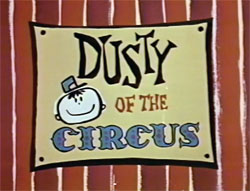 Among the best of this output was a mini-series entitled “Dusty of the Circus”. This set of six episodes featured the strong vocal reads of Walter Tetley as Dusty, circus boy and son of circus owner/ringmaster, P. T. Barnstorm (voiced in most episodes by Stan Freberg). Dusty would be an average little boy, except for one peculiar talent – he can understand the talk of animals, and the animals also understand him. So, he has developed a relationship on conversational terms with every animal in the circus, who greet him by name as he passes and pass the time with him in engaging repartee wherever he goes. Trouble is, no adults seem to hear these conversations, nor will believe Dusty’s attempts to convince them of his literally obtaining information straight from the horse’s (or any other animal’s) mouth – especially his Dad, who is ashamed of his boy’s tall-tale telling, or worse yet, malady, of which people are beginning to talk. This framework leads to a goodly variety of comical situations and misunderstandings, that well sustain the six episodes produced, with clever scenarios and witty dialogue.
Among the best of this output was a mini-series entitled “Dusty of the Circus”. This set of six episodes featured the strong vocal reads of Walter Tetley as Dusty, circus boy and son of circus owner/ringmaster, P. T. Barnstorm (voiced in most episodes by Stan Freberg). Dusty would be an average little boy, except for one peculiar talent – he can understand the talk of animals, and the animals also understand him. So, he has developed a relationship on conversational terms with every animal in the circus, who greet him by name as he passes and pass the time with him in engaging repartee wherever he goes. Trouble is, no adults seem to hear these conversations, nor will believe Dusty’s attempts to convince them of his literally obtaining information straight from the horse’s (or any other animal’s) mouth – especially his Dad, who is ashamed of his boy’s tall-tale telling, or worse yet, malady, of which people are beginning to talk. This framework leads to a goodly variety of comical situations and misunderstandings, that well sustain the six episodes produced, with clever scenarios and witty dialogue.
I will piggyback upon a fairly comprehensive past article written for this website by Mike Kazaleh, which may be viewed here, in which not only the six issued installments of the series were posted, but a previously-unknown “pilot” created by Gene Deitch, which did not follow the story-format of the others at all, nor was even animated, but was conceived entirely with paper cutouts moved by hand to simulate action. The pilot aside, I add to such article’s coverage brief plot synopses of the six TV episodes.
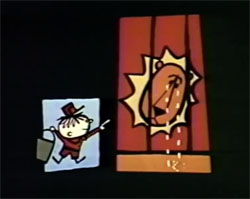 The Sad Lion introduces the series, and Dusty’s primary jobs of driving the circus train and tending to the animals. Dusty shows off the troupe to the television audience, but is periodically pestered by a “silly little boy” who gets in the way – a problem Dusty observes occurs with one kid or another in every town they play. He encounters the kid inside the cage of what is supposed to be their most ferocious lion, and chases the kid away, expecting him to be in danger of having his head bitten off. But the lion begins to cry, sad that Dusty chased him away. The lion is tired of everyone being scared when he roars, and wanted the kid to be his friend. The lion insists that unless someone consents to be his friend, he will not roar anymore. Dusty attempts to convince members of the circus troupe to come over and pet the lion, or he won’t roar anymore, and the circus will lose its star attraction – plus the crowds to pay money for the troupe’s salaries. Though tenuous about it, the troupe members, not wanting to see their pay lost, are almost ready to go along with Dusty, until a thin man with a Ned Sparks’ style voice inquires where Dusty heard that the lion would not roar. Dusty begins to blurt out that he got it straight from the lion, until he sees the glowering face of his Dad looming above him. Repeating the words of his Dad to avoid his ire, Dusty reflexively shouts “Animals can’t talk and that’s final”. Disgusted, Dusty turns away as various animals try to strike up conversations with him, insisting he is no longer on “speaking terms” with them, and wants to be left alone. But a ladybug (who is actually a male and the father of many children) points out that adults have their own concepts of what is “supposed to” and “not supposed to” be, which, as in the case of himself being presumed a lady, are not necessarily true. Still, Dusty needs a way to keep the lion roaring, in spite of the adults’ disbelief and unwillingness to help. As he leads the lion toward his cage, he hears a “glub glub” from a well. It is the silly little kid, fallen in. Dusty leans in to see, and falls in too. He shouts for the lion’s help, insisting that the only thing that can save them is for the lion to attract attention with his loudest roars, to bring people there for a rescue. Despite his resolve to be silent, the lion final roars with gusto. He becomes a hero at alerting the adults to the scene to save the kids, and the public are no longer scared to be near the lion because of his roar, but flock to see him as a celebrity, providing him with all the friends he needs. As the train leaves town, the ladybug asks Dusty about the rescue and his dangerous fall into the well. Dusty reveals the secret that there was no danger, as there wasn’t enough water in the well to come close to reaching his head. Dusty just had to come up with something to get the lion to roar, and used the incident as a ploy to best advantage. The train departs, with the silly little kid hanging on to the caboose.
The Sad Lion introduces the series, and Dusty’s primary jobs of driving the circus train and tending to the animals. Dusty shows off the troupe to the television audience, but is periodically pestered by a “silly little boy” who gets in the way – a problem Dusty observes occurs with one kid or another in every town they play. He encounters the kid inside the cage of what is supposed to be their most ferocious lion, and chases the kid away, expecting him to be in danger of having his head bitten off. But the lion begins to cry, sad that Dusty chased him away. The lion is tired of everyone being scared when he roars, and wanted the kid to be his friend. The lion insists that unless someone consents to be his friend, he will not roar anymore. Dusty attempts to convince members of the circus troupe to come over and pet the lion, or he won’t roar anymore, and the circus will lose its star attraction – plus the crowds to pay money for the troupe’s salaries. Though tenuous about it, the troupe members, not wanting to see their pay lost, are almost ready to go along with Dusty, until a thin man with a Ned Sparks’ style voice inquires where Dusty heard that the lion would not roar. Dusty begins to blurt out that he got it straight from the lion, until he sees the glowering face of his Dad looming above him. Repeating the words of his Dad to avoid his ire, Dusty reflexively shouts “Animals can’t talk and that’s final”. Disgusted, Dusty turns away as various animals try to strike up conversations with him, insisting he is no longer on “speaking terms” with them, and wants to be left alone. But a ladybug (who is actually a male and the father of many children) points out that adults have their own concepts of what is “supposed to” and “not supposed to” be, which, as in the case of himself being presumed a lady, are not necessarily true. Still, Dusty needs a way to keep the lion roaring, in spite of the adults’ disbelief and unwillingness to help. As he leads the lion toward his cage, he hears a “glub glub” from a well. It is the silly little kid, fallen in. Dusty leans in to see, and falls in too. He shouts for the lion’s help, insisting that the only thing that can save them is for the lion to attract attention with his loudest roars, to bring people there for a rescue. Despite his resolve to be silent, the lion final roars with gusto. He becomes a hero at alerting the adults to the scene to save the kids, and the public are no longer scared to be near the lion because of his roar, but flock to see him as a celebrity, providing him with all the friends he needs. As the train leaves town, the ladybug asks Dusty about the rescue and his dangerous fall into the well. Dusty reveals the secret that there was no danger, as there wasn’t enough water in the well to come close to reaching his head. Dusty just had to come up with something to get the lion to roar, and used the incident as a ploy to best advantage. The train departs, with the silly little kid hanging on to the caboose.
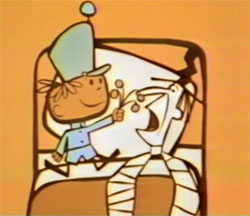 The Five-Cent Nickel finds Dusty on payday, receiving his whopping salary from Dad of four whole cents. One falls out of Dusty’s pants pocket, and is picked up by the Ned Sparks thin man (now named Ebeneezer), who claims right of “finders, keepers”. Dusty shouts to the circus folk that Ebeneezer is a thief, but Ebeneezer covers with, “Will you believe grown-up old me or this child who talks to animals?” The crowd admits Dusty is tetched in the head, and sides with Ebeneezer. Dusty attempts to recruit the help of his friend Bear (performer of a leap through fire on a unicycle in the main show) as a witness to Ebeneezer’s foul deed, but all Bear can state in front of the adults is growls. No one will believe Dusty without proof. In his tent, Ebeneezer stashes away the penny in a piggy bank, then makes a one-cent entry on a personal ledger with the notation, “Took from Dusty”. A storm rises, and a lightning strike sets Ebeneezer’s tent afire, trapping him inside. Ebeneezer tosses out his belongings, but can’t get out himself. Dusty effects a rescue, releasing Bear from his cage, who performs his wall-of-flame ride to scoop up Ebeneezer and remove him from the tent. When Ebeneezer awakens in a hospital bed, the crowd has found his ledger. But Dusty no longer seeks back the penny, having received a five-cent bonus from Dad for his quick thinking. The coin rolls under the bed, and, despite his heavy bandages, Ebeneezer is there in an instant, looking up sheepishly at the crowd, and forced to return the nickel. “Could I just hear it jingle?” asks Ebeneezer. “Aw, go fix your hat”, shouts Dusty, as enough is enough.
The Five-Cent Nickel finds Dusty on payday, receiving his whopping salary from Dad of four whole cents. One falls out of Dusty’s pants pocket, and is picked up by the Ned Sparks thin man (now named Ebeneezer), who claims right of “finders, keepers”. Dusty shouts to the circus folk that Ebeneezer is a thief, but Ebeneezer covers with, “Will you believe grown-up old me or this child who talks to animals?” The crowd admits Dusty is tetched in the head, and sides with Ebeneezer. Dusty attempts to recruit the help of his friend Bear (performer of a leap through fire on a unicycle in the main show) as a witness to Ebeneezer’s foul deed, but all Bear can state in front of the adults is growls. No one will believe Dusty without proof. In his tent, Ebeneezer stashes away the penny in a piggy bank, then makes a one-cent entry on a personal ledger with the notation, “Took from Dusty”. A storm rises, and a lightning strike sets Ebeneezer’s tent afire, trapping him inside. Ebeneezer tosses out his belongings, but can’t get out himself. Dusty effects a rescue, releasing Bear from his cage, who performs his wall-of-flame ride to scoop up Ebeneezer and remove him from the tent. When Ebeneezer awakens in a hospital bed, the crowd has found his ledger. But Dusty no longer seeks back the penny, having received a five-cent bonus from Dad for his quick thinking. The coin rolls under the bed, and, despite his heavy bandages, Ebeneezer is there in an instant, looking up sheepishly at the crowd, and forced to return the nickel. “Could I just hear it jingle?” asks Ebeneezer. “Aw, go fix your hat”, shouts Dusty, as enough is enough.
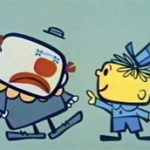 Turned Around Clown is story-wise the weakest episode of the series, most of its footage pushing an original song. Smiley the Clown (Stan Freberg) wows the crowds of kids, until one morning he makes his appearance with a frown on his face. The kids in the audience are disenchanted by the performance – even thinking homework would be more fun – and depart. Smiley has no explanation for the metamorphosis, and asks Dusty for help, wondering where a smile goes when it disappears. Dusty and the animals search, until Dusty spots a poster picture of Smiley that blows off a wall, getting turned upside down. Dusty realizes that Smiley has merely put on his make-up upside down, and a simple 180 degree flip of Smiley’s head transforms him to his old smiling self. Half the cartoon is frittered away in a song (the only one in the series), “A Smile Is a Turned-Around Frown”.
Turned Around Clown is story-wise the weakest episode of the series, most of its footage pushing an original song. Smiley the Clown (Stan Freberg) wows the crowds of kids, until one morning he makes his appearance with a frown on his face. The kids in the audience are disenchanted by the performance – even thinking homework would be more fun – and depart. Smiley has no explanation for the metamorphosis, and asks Dusty for help, wondering where a smile goes when it disappears. Dusty and the animals search, until Dusty spots a poster picture of Smiley that blows off a wall, getting turned upside down. Dusty realizes that Smiley has merely put on his make-up upside down, and a simple 180 degree flip of Smiley’s head transforms him to his old smiling self. Half the cartoon is frittered away in a song (the only one in the series), “A Smile Is a Turned-Around Frown”.
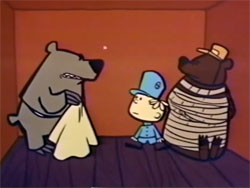 The Bear Scare is a clever game of cops and robbers. A policeman (who speaks in a metallic tone and sounds at all times like he is delivering a 1930’s-style police radio call to the squad cars) is in pursuit of an armed escaped convict, who has run onto the circus grounds. The con (who talks like Edward G. Robinson) ducks into a costume wagon, and emerges at the door dressed in a bear suit. “Oops…I repeat, Oops”, reacts the cop, still in radio-call manner. Dusty makes his morning rounds, to find two bears snarling at one another over the same cage. But one of them packs a gun. Dusty is ordered to tie the real bear up and cover him in one corner of the cage under a canvas, and warned not to “try nothin’”, or the bear gets it. Dusty confers with an elephant and a monkey about the dilemma. The monkey suggests getting the convict into Bear’s wall of fire act. Dusty doesn’t think the con will fall for it – until he decides to embellish the ruse by making the con think milling inside the tent among the crowd is his best chance to make an escape. The con allows himself to be led into the arena, but then spots that while the cop waits at one exit, Dusty’s elephant has been posted by Dusty to block the opposite exit. The con knows it’s a trap, and as a rope is placed around his waist to hoist him up to the bear’s unicycle platform at the top of the ramp leading to the wall of flame, the con grabs Dusty, vowing to take Dusty with him. As the rope is hoisted, the con’s gun drops out of his pocket, and is discovered by the cop. Knowing now the bear is a phoney, the cop quickly checks the cage outside, releasing the real Bear. The cop then pursues the con and Dusty up a ladder to the platform. The con attempts revenge upon Dusty for his betrayal, pushing Dusty onto the slide leading to the flames. The cop arrives, and soon, the con and the cop are both sliding down the ramp, too. The real Bear and the elephant effect a nick-of-time rescue, the elephant dousing the flames with water from its trunk a split-second before Dusty hits, and the bear making a spectacular one-paw catch of Dusty from his unicycle. Bear then leaps upon the con, pinning him to the ground for an arrest. Dusty’s Dad demands an explanation, then overhears the con grumbling to get the Bear off of him. For the only time in the series, Dad nearly faints at having himself heard a voice coming from an animal. “It must be true”, he utters, as he sags to the ground. “Aw, pop…” mutters the frustrated Dusty, knowing this is going to take quite a bit of explanation.
The Bear Scare is a clever game of cops and robbers. A policeman (who speaks in a metallic tone and sounds at all times like he is delivering a 1930’s-style police radio call to the squad cars) is in pursuit of an armed escaped convict, who has run onto the circus grounds. The con (who talks like Edward G. Robinson) ducks into a costume wagon, and emerges at the door dressed in a bear suit. “Oops…I repeat, Oops”, reacts the cop, still in radio-call manner. Dusty makes his morning rounds, to find two bears snarling at one another over the same cage. But one of them packs a gun. Dusty is ordered to tie the real bear up and cover him in one corner of the cage under a canvas, and warned not to “try nothin’”, or the bear gets it. Dusty confers with an elephant and a monkey about the dilemma. The monkey suggests getting the convict into Bear’s wall of fire act. Dusty doesn’t think the con will fall for it – until he decides to embellish the ruse by making the con think milling inside the tent among the crowd is his best chance to make an escape. The con allows himself to be led into the arena, but then spots that while the cop waits at one exit, Dusty’s elephant has been posted by Dusty to block the opposite exit. The con knows it’s a trap, and as a rope is placed around his waist to hoist him up to the bear’s unicycle platform at the top of the ramp leading to the wall of flame, the con grabs Dusty, vowing to take Dusty with him. As the rope is hoisted, the con’s gun drops out of his pocket, and is discovered by the cop. Knowing now the bear is a phoney, the cop quickly checks the cage outside, releasing the real Bear. The cop then pursues the con and Dusty up a ladder to the platform. The con attempts revenge upon Dusty for his betrayal, pushing Dusty onto the slide leading to the flames. The cop arrives, and soon, the con and the cop are both sliding down the ramp, too. The real Bear and the elephant effect a nick-of-time rescue, the elephant dousing the flames with water from its trunk a split-second before Dusty hits, and the bear making a spectacular one-paw catch of Dusty from his unicycle. Bear then leaps upon the con, pinning him to the ground for an arrest. Dusty’s Dad demands an explanation, then overhears the con grumbling to get the Bear off of him. For the only time in the series, Dad nearly faints at having himself heard a voice coming from an animal. “It must be true”, he utters, as he sags to the ground. “Aw, pop…” mutters the frustrated Dusty, knowing this is going to take quite a bit of explanation.
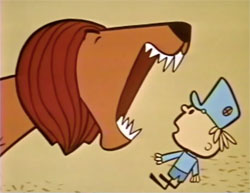 Lion On the Loose – Lion tamer Clyde the Courageous receives shipment of a new man-eater, but can’t get the beast to exit the shipping crate into the arena cage. Dusty suggests (to his father’s embarrassment) merely asking the lion, but when he tries, Dusty is surprisingly shoved backwards by a swiping paw which bursts through one of the slats of the crate. As the show commences, Dusty is instructed by Clyde to jab the new lion from behind with a pole through the hole in the crate at a given signal (though Dusty is sure the beast won’t like it). The lion leaps into the cage, and with a few paw swipes, has severed Clyde’s whip, destroyed his chair – and Clyde’s pistol has run out of bullets. Clyde runs for the entrance chute where the lion came in, but Dusty can’t close the gate behind him, which is stuck, letting the lion also escape. Clyde climbs up a pole, while the lion waits at the base of the pole, roaring with mouth open wide. Dusty attempts to pursue, but himself becomes the pursued, as the chase disrupts juggling acts, the human cannonball, and finally finds the entire cast huddled in a small tent, with the lion also entering behind them. Everyone races out of the tent except Dusty, who is cornered. The lion advances, still roaring with mouth wide – but does not maul nor eat the boy. Instead, it remains sitting with mouth wide open. Dusty, realizing the lion is not mad, looks inside, and spots a bad lower tooth. Tugging and puling, he performs a dental extraction. “Why didn’t you tell me you had a toothache?”, asks Dusty. “Because I do not speak well the English”, responds the lion, (in Daws Butler’s best impression of Charles Boyer). “I am from French Africa”, he further explains. The lion recognizes Dusty from his reputation for talking to animals, but remarks, “I don’t believe it.” Dad and the crowd wonder how Dusty is able to lead the lion tamely out of the tent, and Clyde wonders how he figured out the lion had a toothache. Clyde surmises Dusty is going to claim he just talked to the lion again, and adds “I don’t believe it.” “That’s okay”, responds Dusty for the curtain line, “Neither does the lion.”
Lion On the Loose – Lion tamer Clyde the Courageous receives shipment of a new man-eater, but can’t get the beast to exit the shipping crate into the arena cage. Dusty suggests (to his father’s embarrassment) merely asking the lion, but when he tries, Dusty is surprisingly shoved backwards by a swiping paw which bursts through one of the slats of the crate. As the show commences, Dusty is instructed by Clyde to jab the new lion from behind with a pole through the hole in the crate at a given signal (though Dusty is sure the beast won’t like it). The lion leaps into the cage, and with a few paw swipes, has severed Clyde’s whip, destroyed his chair – and Clyde’s pistol has run out of bullets. Clyde runs for the entrance chute where the lion came in, but Dusty can’t close the gate behind him, which is stuck, letting the lion also escape. Clyde climbs up a pole, while the lion waits at the base of the pole, roaring with mouth open wide. Dusty attempts to pursue, but himself becomes the pursued, as the chase disrupts juggling acts, the human cannonball, and finally finds the entire cast huddled in a small tent, with the lion also entering behind them. Everyone races out of the tent except Dusty, who is cornered. The lion advances, still roaring with mouth wide – but does not maul nor eat the boy. Instead, it remains sitting with mouth wide open. Dusty, realizing the lion is not mad, looks inside, and spots a bad lower tooth. Tugging and puling, he performs a dental extraction. “Why didn’t you tell me you had a toothache?”, asks Dusty. “Because I do not speak well the English”, responds the lion, (in Daws Butler’s best impression of Charles Boyer). “I am from French Africa”, he further explains. The lion recognizes Dusty from his reputation for talking to animals, but remarks, “I don’t believe it.” Dad and the crowd wonder how Dusty is able to lead the lion tamely out of the tent, and Clyde wonders how he figured out the lion had a toothache. Clyde surmises Dusty is going to claim he just talked to the lion again, and adds “I don’t believe it.” “That’s okay”, responds Dusty for the curtain line, “Neither does the lion.”
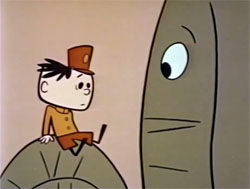 The Elephant Mystery – A weaker entry in the series. Ebeneezer is at it again, mixed up in the middle of a mystery as to why the elephant won’t go on with his act. The elephant merely sulks with its ear partly drooped over its face, and a doctor’s examination yields only a prescription for a pill, and a bill. Dad thinks the act will need to be replaced, and when everuone else leaves, Dusty asks the elephant for an explanation. The elephant flips back its ear, revealing that one of its tusks has been sawed off by a thief in the night. The pachyderm is too embarrassed to go on. Dusty sets a trap, which only succeeds in bagging Dad when he enters the tent during the night to administer the pill to the elephant. But someone is in the tent in full dress instead of his nightshirt, and carrying a violin case. It is Ebeneezer, who inside the case conceals a saw, and the elephant’s second tusk, now also removed. Ebeneezer confesses, stating he needed the ivory for a flea circus he presides over in the side show, which he was trying to make “high class” by constructing ivory castles for the fleas. Ebeneezer can’t answer for what to do to make up for his deed, as he can’t just put the tusks back – but Dusty thinks of a solution. A high-priced animal dentist is called in, and installs a set of golden tusks upon the elephant – guaranteed to make him a bigger hit in the show than he was previously. And Ebeneezer gets the bill.
The Elephant Mystery – A weaker entry in the series. Ebeneezer is at it again, mixed up in the middle of a mystery as to why the elephant won’t go on with his act. The elephant merely sulks with its ear partly drooped over its face, and a doctor’s examination yields only a prescription for a pill, and a bill. Dad thinks the act will need to be replaced, and when everuone else leaves, Dusty asks the elephant for an explanation. The elephant flips back its ear, revealing that one of its tusks has been sawed off by a thief in the night. The pachyderm is too embarrassed to go on. Dusty sets a trap, which only succeeds in bagging Dad when he enters the tent during the night to administer the pill to the elephant. But someone is in the tent in full dress instead of his nightshirt, and carrying a violin case. It is Ebeneezer, who inside the case conceals a saw, and the elephant’s second tusk, now also removed. Ebeneezer confesses, stating he needed the ivory for a flea circus he presides over in the side show, which he was trying to make “high class” by constructing ivory castles for the fleas. Ebeneezer can’t answer for what to do to make up for his deed, as he can’t just put the tusks back – but Dusty thinks of a solution. A high-priced animal dentist is called in, and installs a set of golden tusks upon the elephant – guaranteed to make him a bigger hit in the show than he was previously. And Ebeneezer gets the bill.
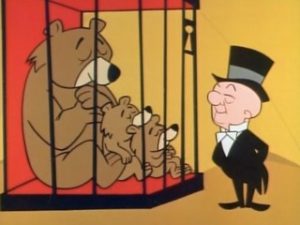 Three Ring Magoo (UPA, The Mister Magoo Show, Paul Fennell, dir.) – Magoo dolls up in top hat, white tie and tails for an annual charity bazaar – an event for the elite with admittance by invitation only. He brings along his houseboy Cholly with a wicker basket to carry the “loot” he expects to win at the various gaming booths. Of course, Magoo’s bad driving and eyesight deficiency deliver him to a circus instead of the bazaar. He hands his invitation to the ticket taker, but Cholly has to cover by paying for real tickets. Magoo generously donates five dollars instead of the usual one for an extra-long kiss at the “kissing booth” – then smooches with a hippopotamus from the menagerie. He tries his hand at his specialty – the ring-toss booth, never realizing that the rings he has borrowed are from the platform of a performing seal. Tossing three rings with one toss, Magoo makes three consecutive ringers – upon one of the antler stubs of a giraffe, another on the nose of an acrobat balancing atop a chair on a high platform, and the third over the eyes of a tightrope walker carrying a heavy barbell as a balance bar, causing him to topple and crash. Magoo attempts to claim his prizes, in the form of two bear cubs from a Mama bear’s cage he thinks is a gift kiosk – but Cholly replaces the cubs just in time to avoid Mama’s wrath. Cholly turns around to find Magoo somehow standing high atop the platform for the high-wire act, and as Magoo asks what’s next on their agenda, Cholly wonders what next indeed. Magoo steps onto an angled wire, and slides down, down, landing in the barrel of a cannon. Cholly thinks this is no place for a man of Magoo’s caliber. Having gone in from one end, there seems to be no way out but the same, so Cholly lights the cannon fuse, observing that Magoo will really be a big shot now. Magoo ricochets off the tent roof, bounces on a trampoline, then zigs and zags back and forth, as observed from outside in the form of visible bulges in the tent fabric everywhere. Cholly comments it is like watching a tennis match. Then, his talk is smothered by the collapse of the tent. Magoo somehow finds his way out from under the canvas, and exits ranting and complaining about being pushed around. Cholly ensures Magoo will not have to answer for the disaster, by leaving a wallet full of Magoo’s credit cards with the ticket taker. Magoo exits into the night, vowing that this is the last bazaar he will ever attend. From now on, charity begins at home.
Three Ring Magoo (UPA, The Mister Magoo Show, Paul Fennell, dir.) – Magoo dolls up in top hat, white tie and tails for an annual charity bazaar – an event for the elite with admittance by invitation only. He brings along his houseboy Cholly with a wicker basket to carry the “loot” he expects to win at the various gaming booths. Of course, Magoo’s bad driving and eyesight deficiency deliver him to a circus instead of the bazaar. He hands his invitation to the ticket taker, but Cholly has to cover by paying for real tickets. Magoo generously donates five dollars instead of the usual one for an extra-long kiss at the “kissing booth” – then smooches with a hippopotamus from the menagerie. He tries his hand at his specialty – the ring-toss booth, never realizing that the rings he has borrowed are from the platform of a performing seal. Tossing three rings with one toss, Magoo makes three consecutive ringers – upon one of the antler stubs of a giraffe, another on the nose of an acrobat balancing atop a chair on a high platform, and the third over the eyes of a tightrope walker carrying a heavy barbell as a balance bar, causing him to topple and crash. Magoo attempts to claim his prizes, in the form of two bear cubs from a Mama bear’s cage he thinks is a gift kiosk – but Cholly replaces the cubs just in time to avoid Mama’s wrath. Cholly turns around to find Magoo somehow standing high atop the platform for the high-wire act, and as Magoo asks what’s next on their agenda, Cholly wonders what next indeed. Magoo steps onto an angled wire, and slides down, down, landing in the barrel of a cannon. Cholly thinks this is no place for a man of Magoo’s caliber. Having gone in from one end, there seems to be no way out but the same, so Cholly lights the cannon fuse, observing that Magoo will really be a big shot now. Magoo ricochets off the tent roof, bounces on a trampoline, then zigs and zags back and forth, as observed from outside in the form of visible bulges in the tent fabric everywhere. Cholly comments it is like watching a tennis match. Then, his talk is smothered by the collapse of the tent. Magoo somehow finds his way out from under the canvas, and exits ranting and complaining about being pushed around. Cholly ensures Magoo will not have to answer for the disaster, by leaving a wallet full of Magoo’s credit cards with the ticket taker. Magoo exits into the night, vowing that this is the last bazaar he will ever attend. From now on, charity begins at home.
Pardon the dub job on Cholly…
Flea Ring Circus (UPA, The Dick Tracy Show) – Police dog Hemlock Holmes sometimes wishes he had the ability to pick his own assignments – especially when Dick Tracy radios him to head for the Dingaling Brothers Circus, where Ferguson’s Flying Fleas have bee stolen from the sideshow. “The things we officers have to do to protect you citizens”, complains Hemlock to the camera. As usual, Hemlock calls out his squad of nameless Keystone Kop types, known together as the Retouchables, and as usual, they take off in their patrol car without Hemlock, leaving the dog to trail along with one paw grabbing the rear fender, then crashing through both windshields onto the hood when the car makes a sudden stop. The car plows through the main tent at the circus grounds, and Hemlock winds up with an elephant seated atop himself on the car’s hood. The elephant points them back to the tent in their search for the fleanappers – who turn out to be Flat Top and BB Eyes, the former holding a large glass cylinder containing the fleas. To get past the good guys, the two villains put on one dress between them, Flat Top appearing in drag, claiming he is bringing a container of “pepper” to his grandmother.
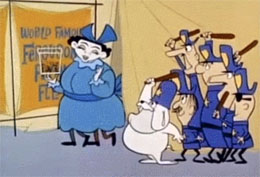 Hemlock notes “she” ought to get there soon, considering that she has four feet – then realizes BB Eyes is within the costume too. The villains are followed to another tent, where the Retouchables guard the entrance to prevent their escape. Hemlock enters, confronting the villains, but is seized and stuffed into a cannon. The cannon shot is fired, while the villains climb a ladder to a trapeze platform. Hemlock ricochets off a bass drum from the circus band, rebounding backwards into the pole which the villains have climbed. The impact knocks loose the flea jar from Flat Top’s hands, which falls and smashes upon Hemlock, showering him with fleas. The Retouchables attempt to head off the villains by climbing the opposite tent pole and swinging toward them on a trapeze. The villains grab the other trapeze, and pass the Retouchables in mid-air. Hemlock races back and forth at ground level, trying to get a net under the Retouchables, but instead crashes headfirst into the second tent pole, on which the villains are now standing. The villains fall into Hemlock’s net, as a happy Hemlock remarks, “Wrong boys, right crooks.” Hemlock reports in at Tracy’s office, announcing that the Retouchables have Flat Top and BB Eyes in custody. Tracy inquires whether Hemlock recovered the fleas. A wild itching and scratching session by Hemlock demonstrates that the fleas are fully present, “alive and biting.”
Hemlock notes “she” ought to get there soon, considering that she has four feet – then realizes BB Eyes is within the costume too. The villains are followed to another tent, where the Retouchables guard the entrance to prevent their escape. Hemlock enters, confronting the villains, but is seized and stuffed into a cannon. The cannon shot is fired, while the villains climb a ladder to a trapeze platform. Hemlock ricochets off a bass drum from the circus band, rebounding backwards into the pole which the villains have climbed. The impact knocks loose the flea jar from Flat Top’s hands, which falls and smashes upon Hemlock, showering him with fleas. The Retouchables attempt to head off the villains by climbing the opposite tent pole and swinging toward them on a trapeze. The villains grab the other trapeze, and pass the Retouchables in mid-air. Hemlock races back and forth at ground level, trying to get a net under the Retouchables, but instead crashes headfirst into the second tent pole, on which the villains are now standing. The villains fall into Hemlock’s net, as a happy Hemlock remarks, “Wrong boys, right crooks.” Hemlock reports in at Tracy’s office, announcing that the Retouchables have Flat Top and BB Eyes in custody. Tracy inquires whether Hemlock recovered the fleas. A wild itching and scratching session by Hemlock demonstrates that the fleas are fully present, “alive and biting.”
Time-compressed and at a dutch angle…
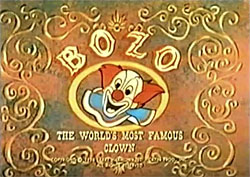 Yet another entertainment medium – children’ records – would be responsible for producing an iconic circus animation star. In the late 1940’s, Capitol Records would introduce and adopt as the official mascot of its label Bozo the Capitol Clown, in a best-selling “record-reader” set, “Bozo at the Circus”. The part of Bozo was originally performed by Pinto Colvig (voice of Goofy), who had been an actual clown early in his career. Colvig would produce many subsequent sets with profitable sales for the label. In the 1950’s. with the backing of new producer Larry Harmon, decision was made to bring Bozo to the animated screen. Colvig’s services were not retained, as Harmon himself took a liking to voicing the clown in his own manner, saving on the need to pay for outside voice-overs. Affordable Paul Frees would aid and abet Harmon on Bozo’s many adventures. The series was produced in two large batches – an initial series of six-minute episodes, opening with stock footage of Bozo being fired out of a cannon and landing on the seat of a miniature clown fire truck, and a second series of five-minute episodes, with Bozo driving a clown car in a theme-park named “Bozoworld”. The latter series (which I believe features direction by Paul Fennell, whose credits date back to at least 1940 and ‘41, with Columbia releases of “The Carpenters” and the “This Changing World” series) is the more-commonly available, mined in its virtual entirety in various VHS tape editions. The earlier films have become quite scarce, possibly from concerted efforts to keep them off the internet from present rights-holders. As of this writing, there’s some good news in this department, as many telecasts of various live-Bozo shows featuring inserts of a Bozo cartoon within have surfaced, accounting for approximately 25 to 30 titles from the early series. Many, however, are still sadly missing, as production during this period was quite prolific.
Yet another entertainment medium – children’ records – would be responsible for producing an iconic circus animation star. In the late 1940’s, Capitol Records would introduce and adopt as the official mascot of its label Bozo the Capitol Clown, in a best-selling “record-reader” set, “Bozo at the Circus”. The part of Bozo was originally performed by Pinto Colvig (voice of Goofy), who had been an actual clown early in his career. Colvig would produce many subsequent sets with profitable sales for the label. In the 1950’s. with the backing of new producer Larry Harmon, decision was made to bring Bozo to the animated screen. Colvig’s services were not retained, as Harmon himself took a liking to voicing the clown in his own manner, saving on the need to pay for outside voice-overs. Affordable Paul Frees would aid and abet Harmon on Bozo’s many adventures. The series was produced in two large batches – an initial series of six-minute episodes, opening with stock footage of Bozo being fired out of a cannon and landing on the seat of a miniature clown fire truck, and a second series of five-minute episodes, with Bozo driving a clown car in a theme-park named “Bozoworld”. The latter series (which I believe features direction by Paul Fennell, whose credits date back to at least 1940 and ‘41, with Columbia releases of “The Carpenters” and the “This Changing World” series) is the more-commonly available, mined in its virtual entirety in various VHS tape editions. The earlier films have become quite scarce, possibly from concerted efforts to keep them off the internet from present rights-holders. As of this writing, there’s some good news in this department, as many telecasts of various live-Bozo shows featuring inserts of a Bozo cartoon within have surfaced, accounting for approximately 25 to 30 titles from the early series. Many, however, are still sadly missing, as production during this period was quite prolific.
 Films from the first series of the Bozo run were generally written by Charles Shows, and would, some of the time, feature plotlines that genuinely involved circus situations and life under the big top. Such did not, however, remain the case as the series progressed, with ever-increaing numbers of episodes featuring the clown as an all-purpose comic hero to drop into any locale or situation desired. By the Bozoworld period, true circus stories seem to have vanished entirely. Thus, I will spotlight a select few titles from the first series for mention, which stick more to the program of this article than others.
Films from the first series of the Bozo run were generally written by Charles Shows, and would, some of the time, feature plotlines that genuinely involved circus situations and life under the big top. Such did not, however, remain the case as the series progressed, with ever-increaing numbers of episodes featuring the clown as an all-purpose comic hero to drop into any locale or situation desired. By the Bozoworld period, true circus stories seem to have vanished entirely. Thus, I will spotlight a select few titles from the first series for mention, which stick more to the program of this article than others.
For featured viewing is Bozo the Lion-Hearted (included within a Bozo half-hour at 6:38). Fearless Freddie the lion tamer is not a man who lives up to his name. With a voice and disposition similar to Droopy, he is knocked out of the big cage by the lions he is supposed to tame, asking if anyone got the number of that truck. For lack of a replacement, Bozo is ordered by the ringmaster to take Freddie’s place. In the same basic setup as Amos ‘n’ Andy’s The Lion Tamer, Bozo concocts a scheme with Butch the circus boy to have the boy don a lion suit, so that Bozo can safely perform the act. But the circus roustabouts wheel in the wrong cage, containing the real lion. By the end of the episode, the lion has the whip and chair, and it is Bozo who is jumping through hoops and leaping from platform to platform, performing the lion’s stunts, and even the lion’s roar.
Other circus stories, too numerous for imbedding here, include Kitty Kat Spat, an episode quite close to the one reviewed above, except that Fearless Freddie and Bozo are taming a tiger rather than a lion. This time, the tiger gets loose, while Bozo mistakes him for a common house cat Butch was painting stripes on. Bozo and the beast hide inside an old trunk, until Bozo hears Butch outside with the cat, and realizes he’s locked in with the real tiger. Bozo’s feet emerge through the boards of the trunk, and the two climb to the high wire in the confusion, then fall. Bozo lands on top, knocking out the tiger cold. In “The Space Ace Saves Face”, a space ship crashes within the circus grounds, bearing an invisible alien. Bozo talks the ringmaster into putting him into an act in the show, but the paying customers yell, “fraud”, refusing to believe the alien is there because they can’t see him, and landing Bozo and the ringmaster in the clink. Butch is only able to secure their release by covering the alien in spray paint to prove his existence to the sheriff.
Please Please Hercules (adapted for Capitol Records as “Bozo and the Talking Elephant”) either borrows or concurrently arrives at the same basic idea as “Dusty of the Circus”, with no one believing Bozo’s claim that he can talk with the circus elephant Hercules. However, when the payroll wagon is robbed by two hoods, Hercules is the only witness who saw the getaway car. He points out the car’s tracks with his trunk, and trumpets the digits of the car’s license plate. Bozo and Butch are captured upon locating the hoods, and tied up in a cellar. As the circus parade leaves town without them, Bozo hollers out a basement window for Hercules (in a shot notable for continuity error, depicting Bozo’s hands as free despite being tied up in all other shots). Hercules charges to the rescue, breaking out our heroes and giving the bad guys a whomping with his trunk. In a surprise ending, as Bozo remarks how no one believed he could talk to elephants, Hercules turns to the audience, and utters clear as day “Ridiculous.” And a personal favorite, of which I can only comment from memory, “Bozo Meets King Glum of Gloom”, a twist on the old fable “The Princess Who Never Laughed”. As the circus passes through a small kingdom on a world tour, its ruler, who never smiles, learns of Bozo’s reputation as “The World’s Most Famous Clown”, and puts him to the test by ordering a command performance by the clown, decreeing that he either produce laughter from the king, or be sentenced to the dungeon. Bozo’s best efforts are a total flop with the deadpan king, and Bozo is indeed placed behind bars. However, his escape efforts somehow result in a comical situation that ultimately has the king in stitches.
Harmon’s other television venture was a run of Popeye cartoons produced alongside the work of about a half-dozen other studios for the 1960 King Features television package. Among these was Muskels Shmuskels (Paul Fennell, dir.), in which Bluto (renamed Brutus for TV) once again plays a strong man, in a circus sideshow. Popeye is as usual frustrated with Bluto’s flirtations with Olive, but Olive has Popeye promise there will be no fighting. Bluto lifts a bar of round weights with his teeth, but Popeye reveals his fraud by popping one of the weights with a pin – merely balloons. Bluto rigs a weight-lifting challenge to prevent Popeye from lifting a set of barbells – by bolting the weights to the floor. Popeye tosses a heavy weight that almost removes Bluto’s head, but Olive again reminds Popeye of his promise. The uneven script has Popeye attempting to avoid battle, hiding out (in a lion’s cage), floating skyward with ballons (which Bluto pops with well-aimed shots from a shooting-gallery rifle), bouncing off a trampoline (with socks from Bluto on a platform above), and fired from a cannon, leaving Popeye in a silhouette-shaped crater in the ground. Bluto fixes to finish Popeye off by pouring into the crater quick-drying cement. That’s all Popeye can stand, and he sucks out his spinach can from under his hat with an inhale from his pipe. As Popeye shatters the cement with the force of an earthquake, Bluto remarks, “Oops” – but in POPEYE’s voice – a wild and careless continuity error. Promise or no promise, the fight is on, and Popeye inflates his fist into a mallet, launching Bluto from a high-striker to ring the bell, then presents Bluto with a cigar. Olive concedes this last gesture was that of a real gentleman – until the cigar explodes in Bluto’s face.
More TV memories next week.


 Charles Gardner is an animation enthusiast who toils by day as a member of LA Law – but by nights and weekends indulges in classic jazz and ragtime as a performer; and studies classic Hollywood cartoons… maybe a little too much.
Charles Gardner is an animation enthusiast who toils by day as a member of LA Law – but by nights and weekends indulges in classic jazz and ragtime as a performer; and studies classic Hollywood cartoons… maybe a little too much.


































































































































































I’m very disappointed with the dubbed dialogue in “Three Ring Magoo”. Cholly just isn’t Cholly without all the extra Ls in his speech (“Slolly, Mister Magloo, bloss!”). But at least they didn’t turn him into an Irish woman.
Those Bozo cartoons are better than I remember them being. I’m glad that more of the early ones have surfaced, and I hope that those still missing eventually turn up as well. Bozo was a big part of childhood for a whole generation of kids, and even if his brand of entertainment has become somewhat passé, it deserves to be preserved and remembered.
Not that it matters, but those knobs on a giraffe’s skull aren’t “antler stubs”. Only members of the deer family have antlers. Giraffes and okapis have ossicones. And that’s your useless anatomical term of the day.
As Bozo always said, JUST… KEEP… LAUGHING!!!
What with their Ed Benedict character designs, Charles Shows’ patented rhyming dialogue, and Capitol Records needle-drop cues, the Bozo TV shorts practically come across as fake Hanna-Barbera cartoons (pre-1960)–Minus the humor and charm, of course.
Was waiting for someone to bring this up, but Martin & Lewis’ final film as a team was Hollywood or Bust (1956).
Magoo’s houseboy in the made-for TV shorts is named Charley/Charlie, not “Cholly” – the character pronounces it “Cholly” due to his being an outdated Asian stereotype.
Sadly, you are wrong. His official name is “Cholly” as seen on studio model sheets – and as part of an actual cartoon title…
Funny that the model sheet gives the star’s name as “Mr McGoo” and also has a picture of a “metranome”. I won’t be adopting either of those spellings, but I will stick with “Cholly”.
Also, that title card is making me hungry for Magoo Gai Pan with Chilli….
Watching the Popeye cartoons made by Larry Harmon, you always expect Bozo to appear (which might have helped). It’s nice to read about Paul Frees being “affordable.” Talk about your bargains.
It’s truly unfortunate that the 1956 “Gerald McBoingBoing Show” is so unavailable. I’d figured it was as much because of competition with the more recent McBoingBoing show as any rights issue. Bits of it appeared as filler on cable channels in the late ’80s, and there were a few half-hour-long VHS collections available (the DVD is just the theatrical shorts, I believe). Someone even attempted to “recreate” several episodes on YouTube, but put them together rather arbitrarily, even though it’s not difficult to look up which episode contained what. I don’t know about you, but I’d pay money for access to the show, particularly the songs that weren’t included in the VHS collection. But then I think absolutely everything should be available for streaming on an a la carte basis, because sitting on content only encourages bootlegging.
“Someone even attempted to “recreate” several episodes on YouTube, but put them together rather arbitrarily, even though it’s not difficult to look up which episode contained what.”
I think you’re referring to my recreations. I had to look up old Newspaper listing for them as the online listings are pretty much wrong. My version was based off how they aired, NOT how they were produced (i’ll probably recreate the production versions though)
I used to watch the made-for-TV Dick Tracys as a kid, and I’ve always wondered who “Xenia” was.
Xenia Beckwith (1909-1998) was one of the first female animators. She did ink and paint at Iwerks, Mintz, and MGM, was an inbetweener at Fleischer during the Miami years, and became a full animator at Lantz during the war. Later she animated at Hanna-Barbera, DePatie-Freleng and Filmation as well as UPA.
Thank you Paul. I knew someone here would have the answer!